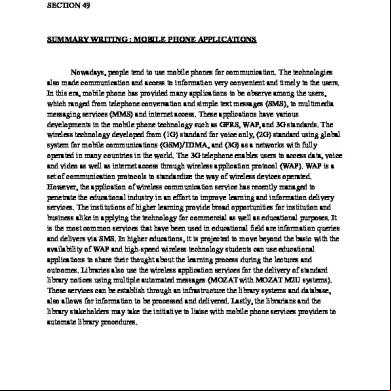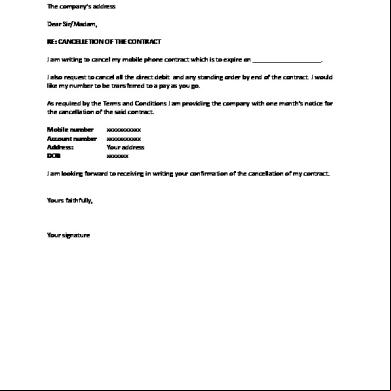Summary (mobile Phone Application) 383v4v
This document was ed by and they confirmed that they have the permission to share it. If you are author or own the copyright of this book, please report to us by using this report form. Report 2z6p3t
Overview 5o1f4z
& View Summary (mobile Phone Application) as PDF for free.
More details 6z3438
- Words: 402
- Pages: 2
NURUL AMIRA BINTI MD NORDIN DF130058 SECTION 49
SUMMARY WRITING : MOBILE PHONE APPLICATIONS
Nowadays, people tend to use mobile phones for communication. The technologies also made communication and access to information very convenient and timely to the s. In this era, mobile phone has provided many applications to be observe among the s, which ranged from telephone conversation and simple text messages (SMS), to multimedia messaging services (MMS) and internet access. These applications have various developments in the mobile phone technology such as GPRS, WAP, and 3G standards. The wireless technology developed from (1G) standard for voice only, (2G) standard using global system for mobile communications (GSM)/TDMA, and (3G) as a networks with fully operated in many countries in the world. The 3G telephone enables s to access data, voice and video as well as internet access through wireless application protocol (WAP). WAP is a set of communication protocols to standardize the way of wireless devices operated. However, the application of wireless communication service has recently managed to penetrate the educational industry in an effort to improve learning and information delivery services. The institutions of higher learning provide broad opportunities for institution and business alike in applying the technology for commercial as well as educational purposes. It is the most common services that have been used in educational field are information queries and delivers via SMS. In higher educations, it is projected to move beyond the basic with the availability of WAP and high-speed wireless technology students can use educational applications to share their thought about the learning process during the lectures and outcomes. Libraries also use the wireless application services for the delivery of standard library notices using multiple automated messages (MOZAT with MOZAT M2U systems). These services can be establish through an infrastructure the library systems and database, also allows for information to be processed and delivered. Lastly, the librarians and the library stakeholders may take the initiative to liaise with mobile phone services providers to automate library procedures.
QUESTIONS a) b) c) d) e) f)
What is the services system that use in the library? What is the benefit of using mobile phone application? List the mobile phones application. What is the purpose of using mobile phone in education? How mobile phones can be used to automate library procedures? How students apply the technologies in their studies? g) What is the common application services that used in education?
SUMMARY WRITING : MOBILE PHONE APPLICATIONS
Nowadays, people tend to use mobile phones for communication. The technologies also made communication and access to information very convenient and timely to the s. In this era, mobile phone has provided many applications to be observe among the s, which ranged from telephone conversation and simple text messages (SMS), to multimedia messaging services (MMS) and internet access. These applications have various developments in the mobile phone technology such as GPRS, WAP, and 3G standards. The wireless technology developed from (1G) standard for voice only, (2G) standard using global system for mobile communications (GSM)/TDMA, and (3G) as a networks with fully operated in many countries in the world. The 3G telephone enables s to access data, voice and video as well as internet access through wireless application protocol (WAP). WAP is a set of communication protocols to standardize the way of wireless devices operated. However, the application of wireless communication service has recently managed to penetrate the educational industry in an effort to improve learning and information delivery services. The institutions of higher learning provide broad opportunities for institution and business alike in applying the technology for commercial as well as educational purposes. It is the most common services that have been used in educational field are information queries and delivers via SMS. In higher educations, it is projected to move beyond the basic with the availability of WAP and high-speed wireless technology students can use educational applications to share their thought about the learning process during the lectures and outcomes. Libraries also use the wireless application services for the delivery of standard library notices using multiple automated messages (MOZAT with MOZAT M2U systems). These services can be establish through an infrastructure the library systems and database, also allows for information to be processed and delivered. Lastly, the librarians and the library stakeholders may take the initiative to liaise with mobile phone services providers to automate library procedures.
QUESTIONS a) b) c) d) e) f)
What is the services system that use in the library? What is the benefit of using mobile phone application? List the mobile phones application. What is the purpose of using mobile phone in education? How mobile phones can be used to automate library procedures? How students apply the technologies in their studies? g) What is the common application services that used in education?





